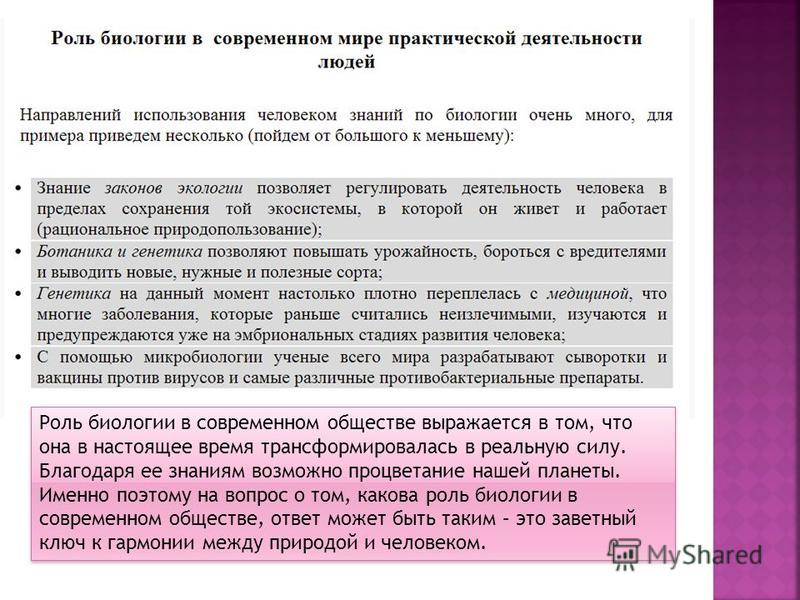Biology Biology - This is a set of sciences about wildlife From the Greek. "bios" - "life", "logos" - "science! The subject of her research is the diversity of manifestations of life: the structure and functions of living organisms, natural communities; Their origin and distribution; Connections with each other and inanimate nature. Diversity of manifestations of life: Structure and functions of living organisms, natural communities; Their origin and distribution; Connections with each other and inanimate nature.
The concept of biology is already mentioned in the writings of T. Roose, 1797 and C. Burdach, but was specially proposed as a term by J. B. Lamarck and G. R. Treviranus in 1802, independently of each other. Jean Baptiste Pierre Antoine de Monet Lamarck 1. The science of biology.

Gottfried Reinhold Treviranus (gg) German naturalist, professor of mathematics and medicine at the gymnasium (Gymnasium illustre) Bremen. German naturalist, professor of mathematics and medicine at the gymnasium (Gymnasium illustre) Bremen. One of the founders of floristic biogeography. One of the founders of floristic biogeography.
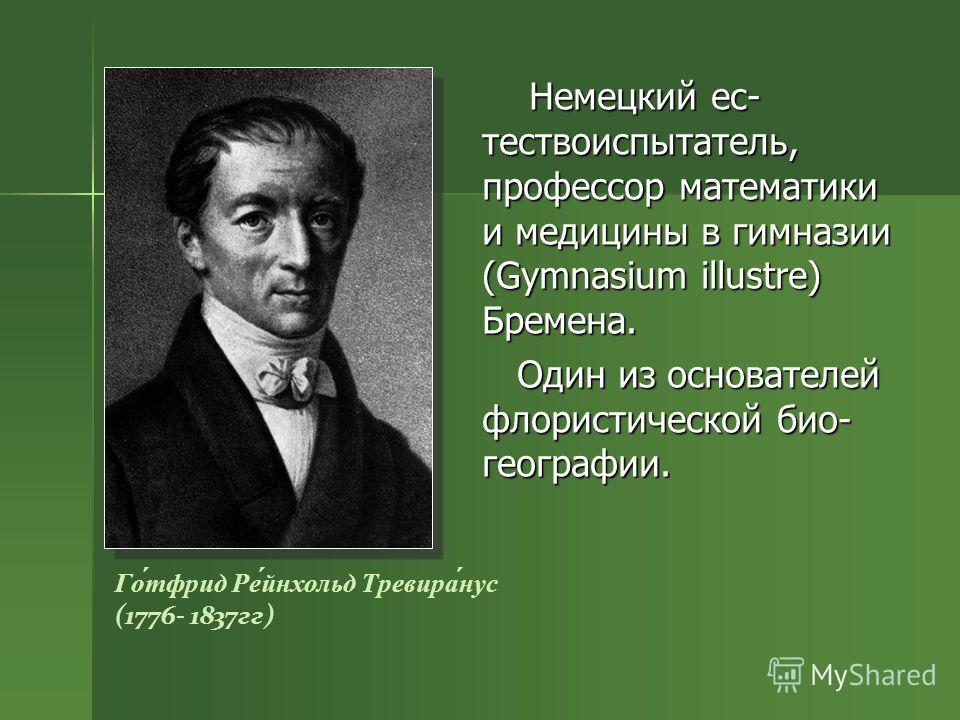
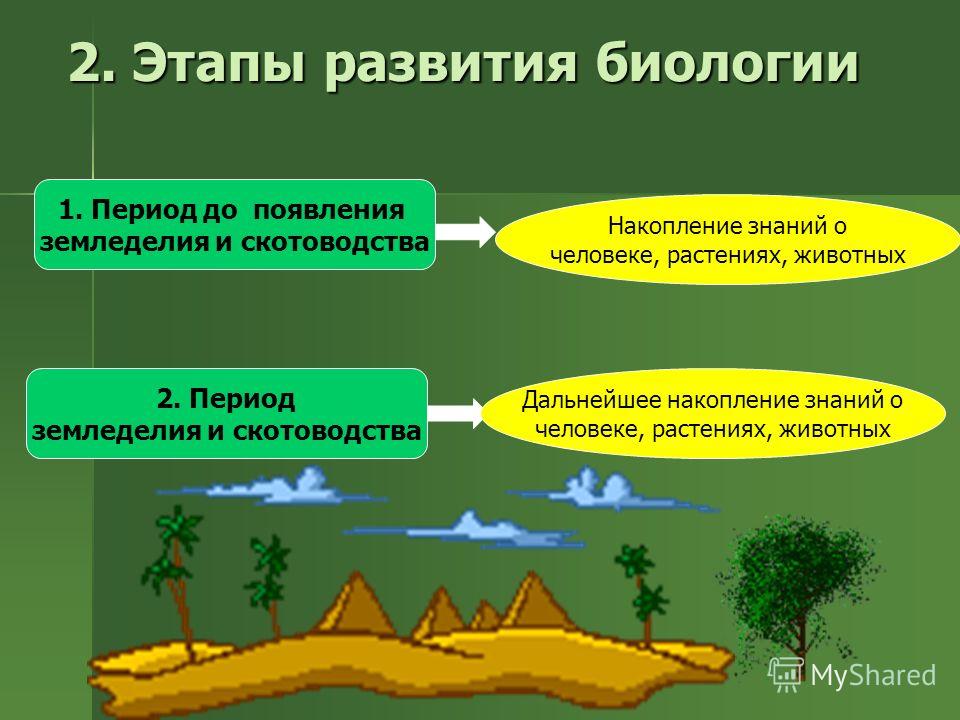
3. The emergence of ancient states (Greece, Rome) Systematization of knowledge about man, plants, animals AristotleTheophrastus Galen Described about 500 species of animals. He created the first system of their classification. Laid the foundations of comparative anatomy. He believed that living matter arose from the inanimate "Father" of botany. Described various organs plants. He laid the foundations for the classification of plants. He believed that living matter arose from non-living An outstanding Roman physician. "Father" of medicine. Describe the human organs. Laid the foundations of human anatomy. The basis for the development of European biological science, did not change until the VIII century. AD
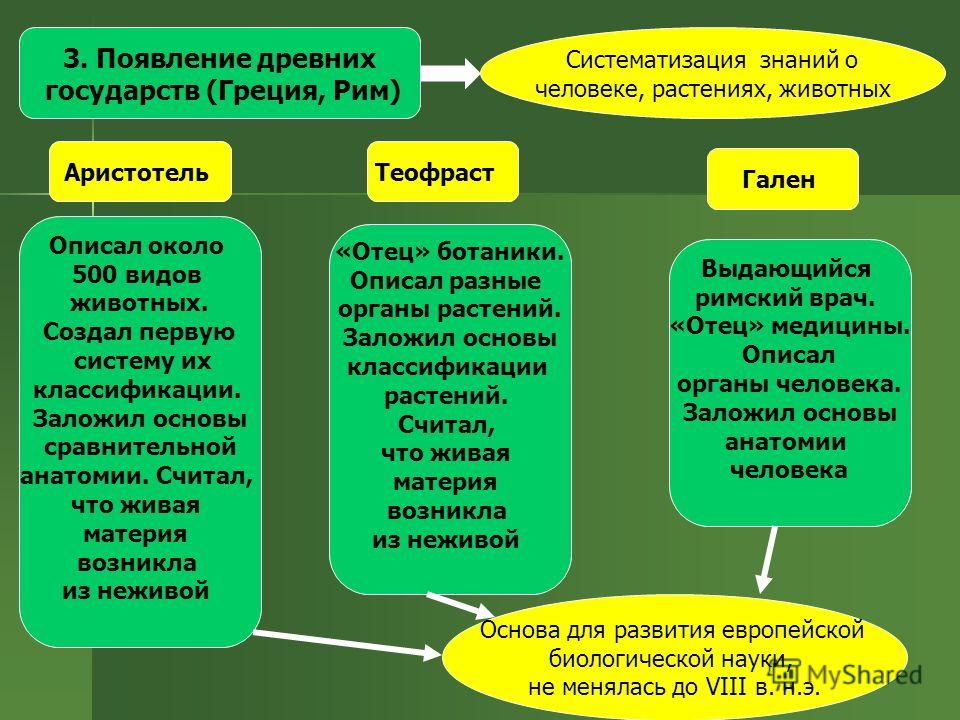
Aristotle (384-322 BC) GALEN (AD) Theophrastus (372-287 BC)
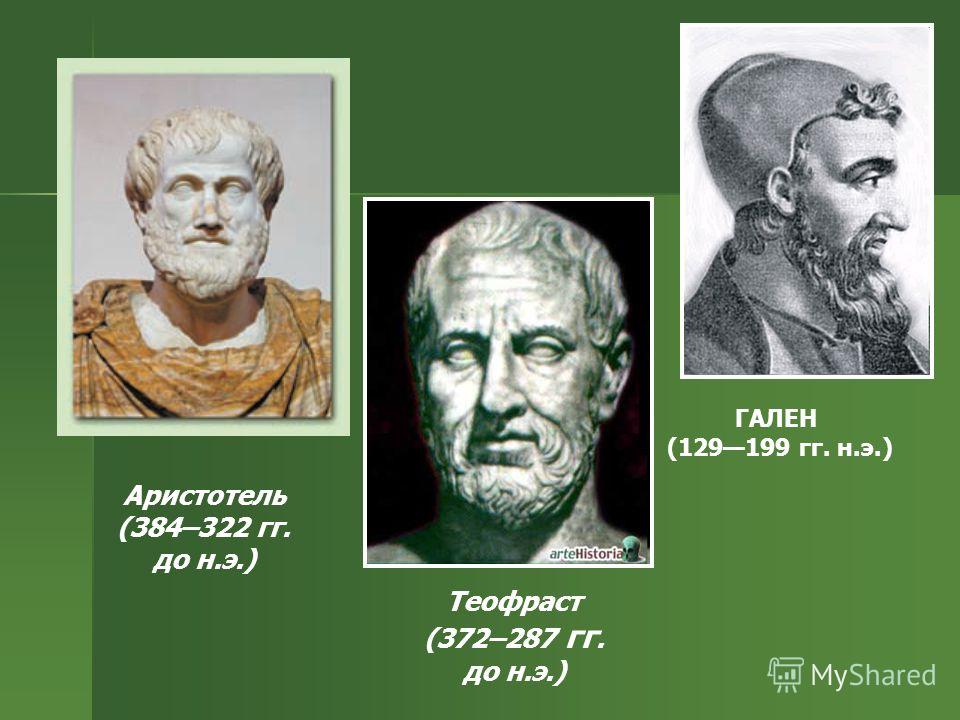
4. The Middle Ages (5th–15th centuries AD) Slowdown in the development of biology, the predominance of religious views on the creation of matter by God Biology developed mainly as a descriptive science. The accumulated facts were often distorted. For example, there are descriptions of various mythical creatures, such as the “sea monk”, who seemed to appear to sailors before a storm, sirens, mermaids, octopuses, etc.
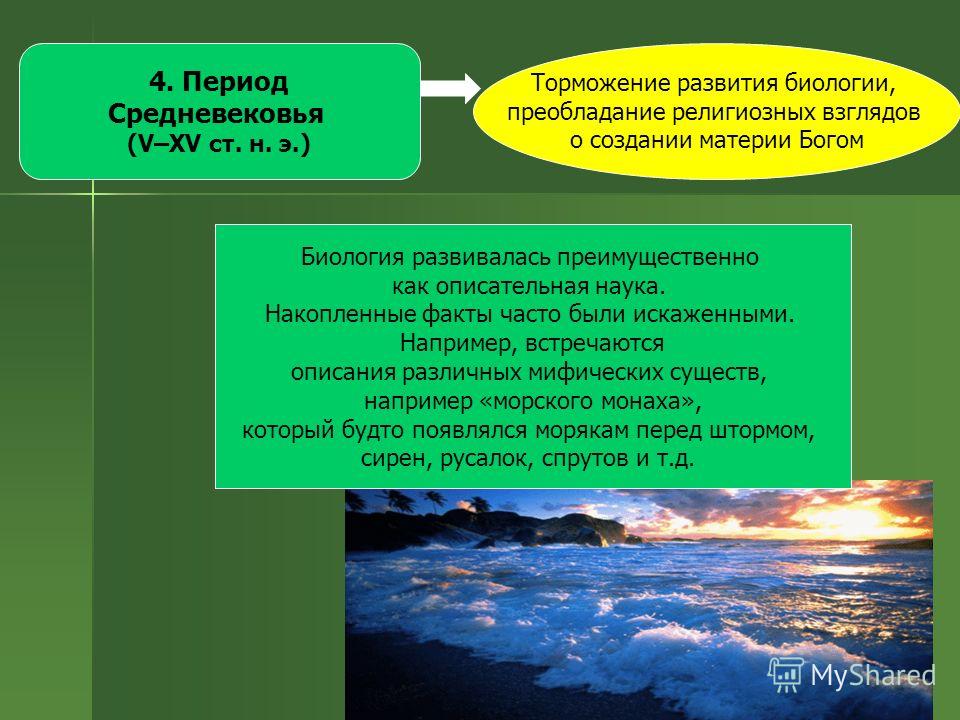
5. Renaissance period (XVI–XVIII centuries AD) Development of biological science, study of the structure and functions of various biological objects Robert Hooke (1635–1703) Invention of the microscope, introduction of the term “cell” Anthony van Leeuwenhoek (1632–1723) Observed unicellular organisms, blood cells Carl Linnaeus (1707–1778) Introduced the term “species”. He founded modern taxonomy, and also matured his own classification of plants and animals. Introduced Latin scientific names of species, genera and other systematic categories, described over 7,500 plant species and about 4,000 animal species
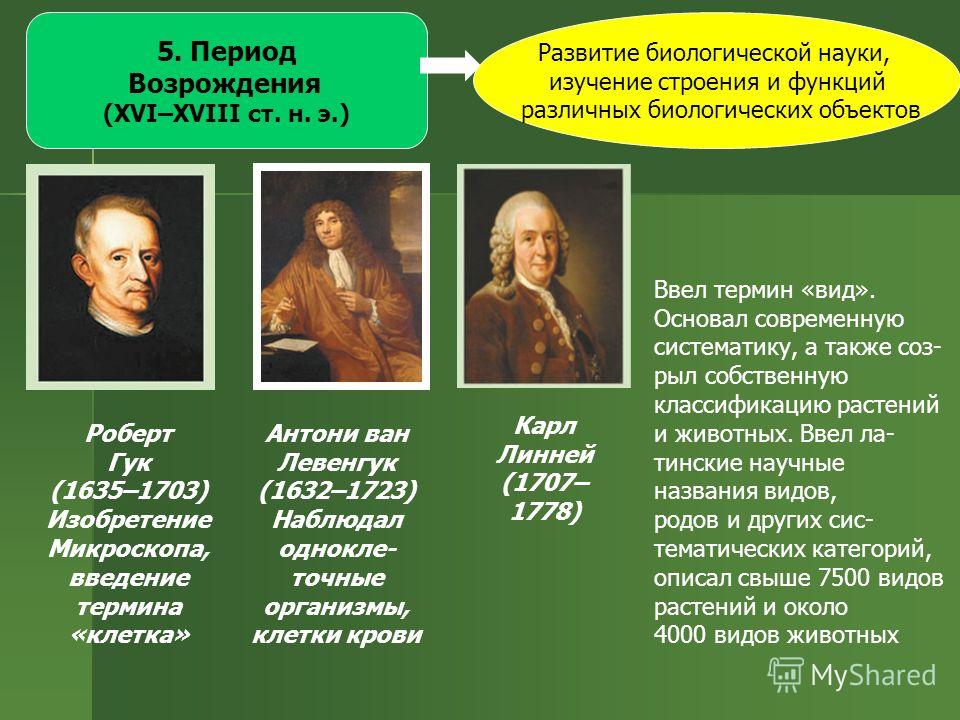
6. Creation of the cellular theory and development of evolutionary ideas (19th century AD) A sharp surge in the development of biology, the struggle between materialistic and idealistic views on the origin of matter Theodor Schwann (1810–1882) One of the authors of the cellular theory (Schleiden and Virchow) Jean- Baptiste Lamarck (1744–1829) Author of the first evolutionary doctrine Charles Darwin (1809–1882) Author of the first evolutionary theory Ernst Haeckel (1834–1919) Introduced the term “ecology”. Laid the foundations of phylogeny
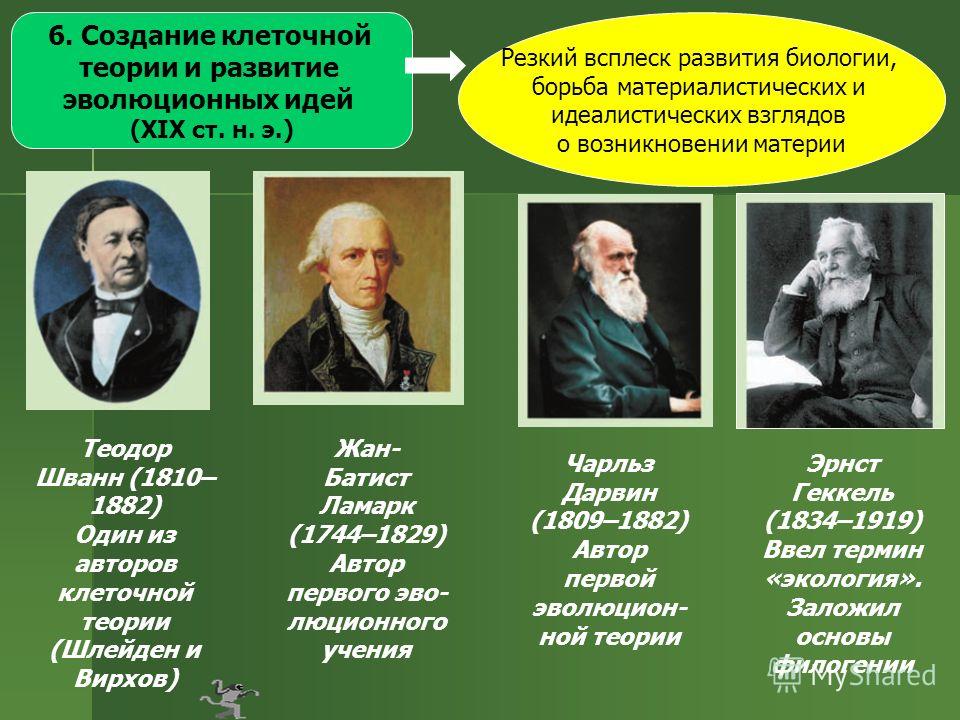
7. "Genetic" period (since 1900) The prevalence of materialistic views, the discovery of patterns of heredity and variability Hugh de Vries (1848-1935) The term "mutation" Erich Cermak (1871-1962) Carl Correns (1864-1933) William Betson (1861 –1926) The term "genetics" (1908) Thomas Hunt Morgan Chromosomal theory of heredity Watson and Crick The structure of DNA (1953) Gregor Mendel (1822–1884)
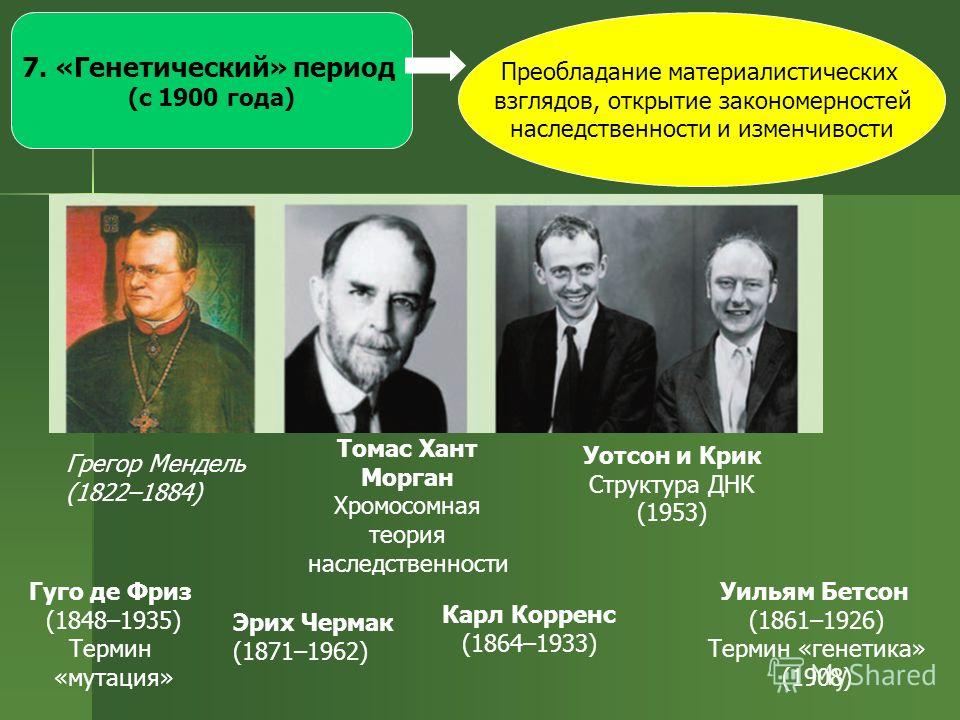
Development of molecular biology, genetic engineering, biotechnology Severo Ochoa (1905-1993) and Arthur Kornberg (1918-2001) - the mechanism of RNA and DNA biosynthesis Marshall Nirenberg (1927-2010), Robert Holly (1922-1993), Hara Gobinda Horani (1922 –2010) - transcript genetic code and its role in protein synthesis H.G. Khorana - the first gene synthesis in 1969.
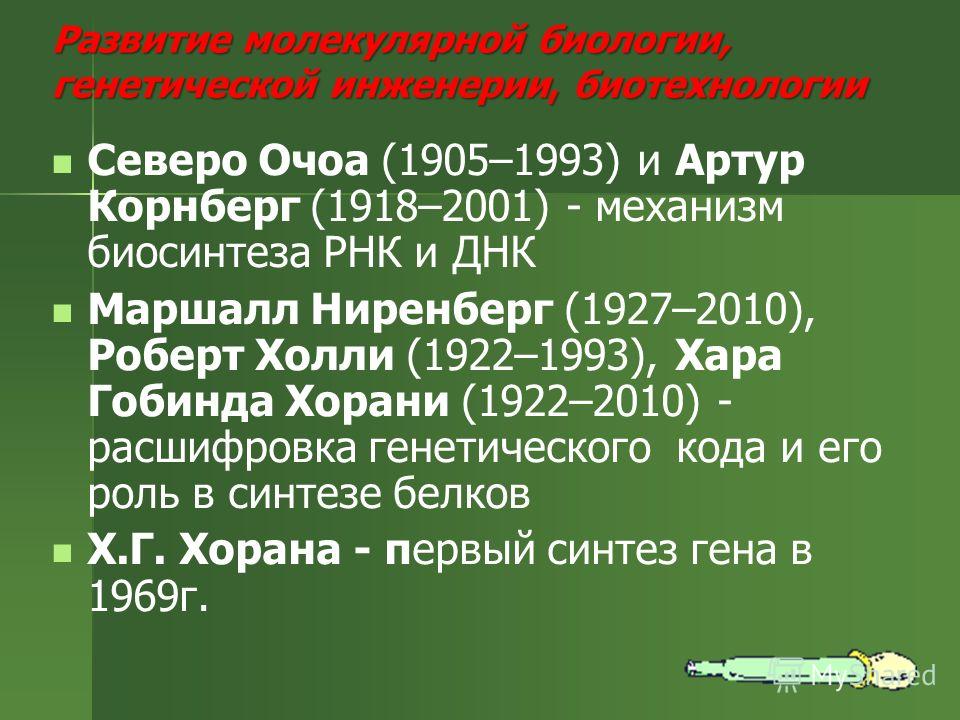

3. Methods of biological research Descriptive method. descriptive method. descriptive method. descriptive method. Experiment Experiment Experiment Comparative method Comparative method Comparative method Comparative method Historical method Historical method Historical method Historical method Simulation method Simulation method Simulation method Simulation method
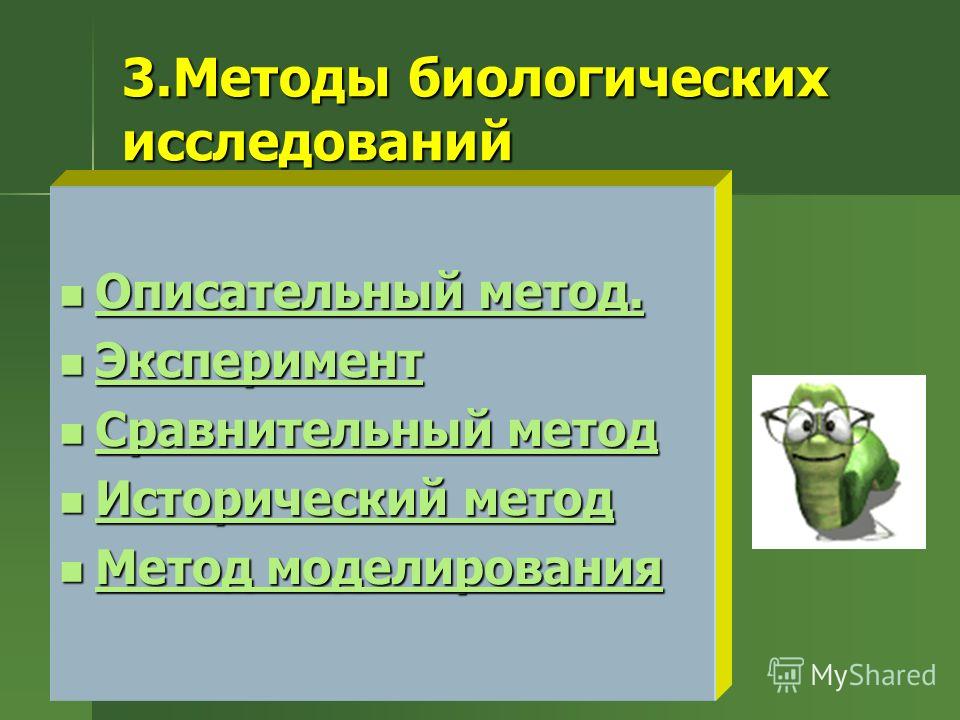
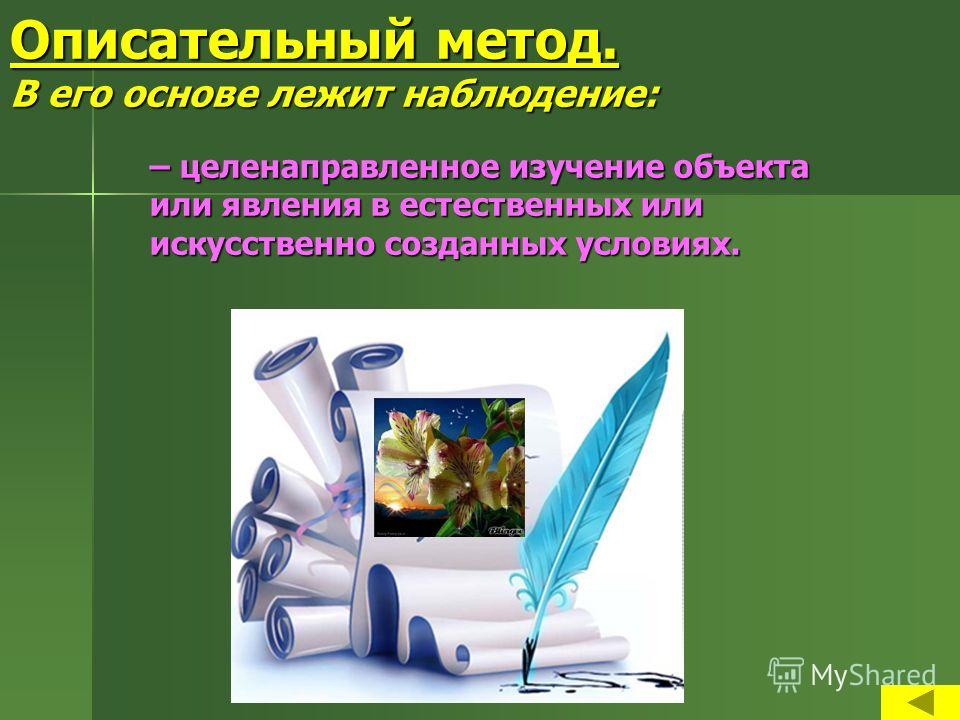
Experiment: under artificially created conditions, the response of a particular object to a change in one or more external factors. under artificially created conditions, the response of a particular object to a change in one or more external factors is studied.

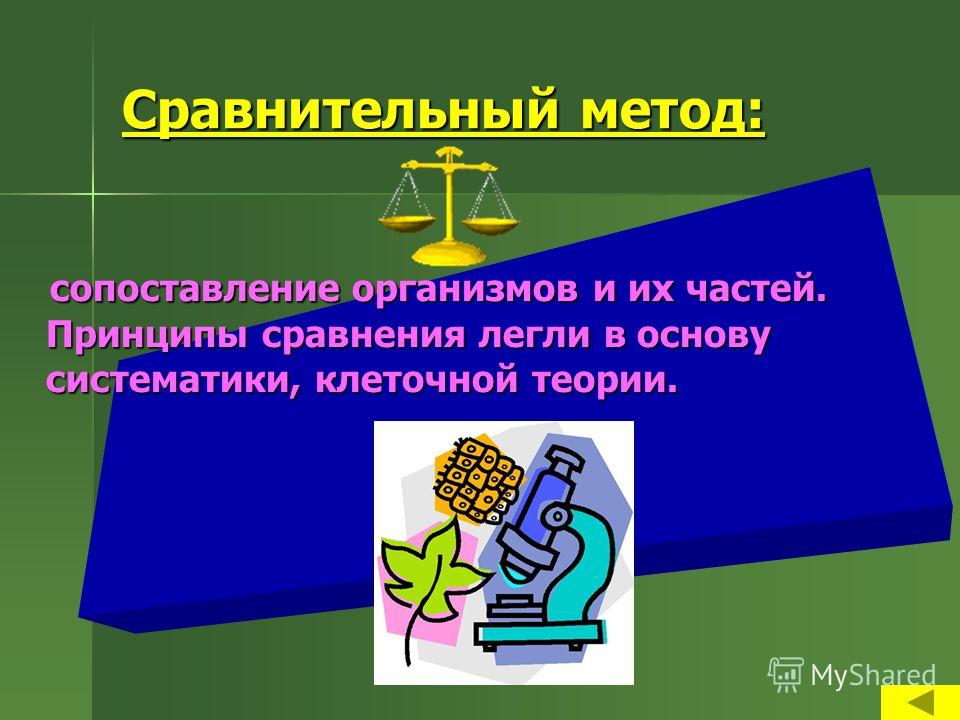
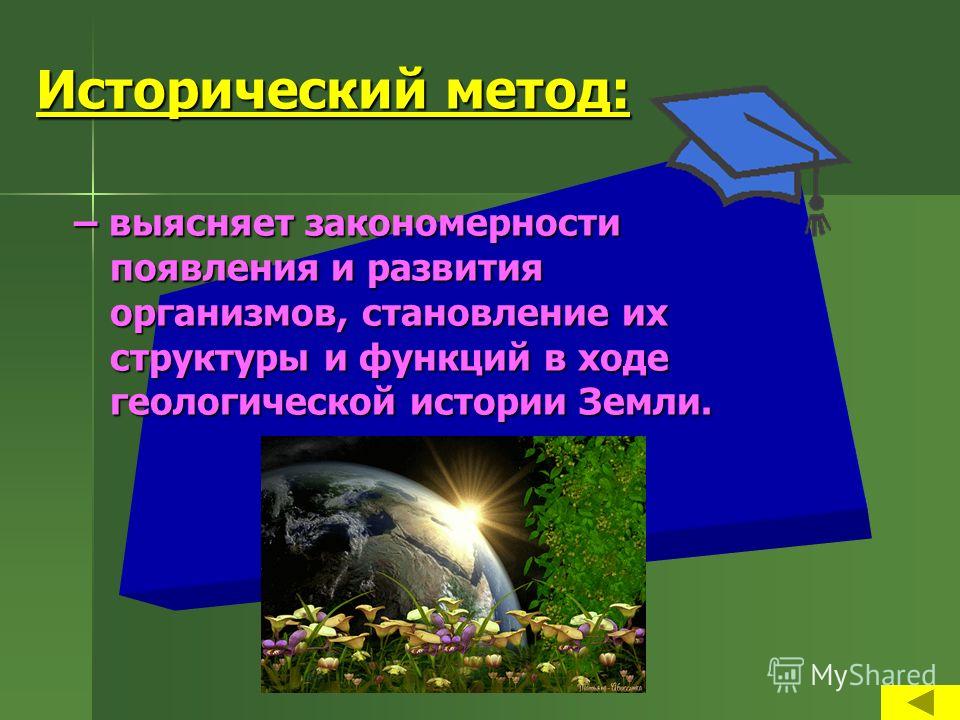
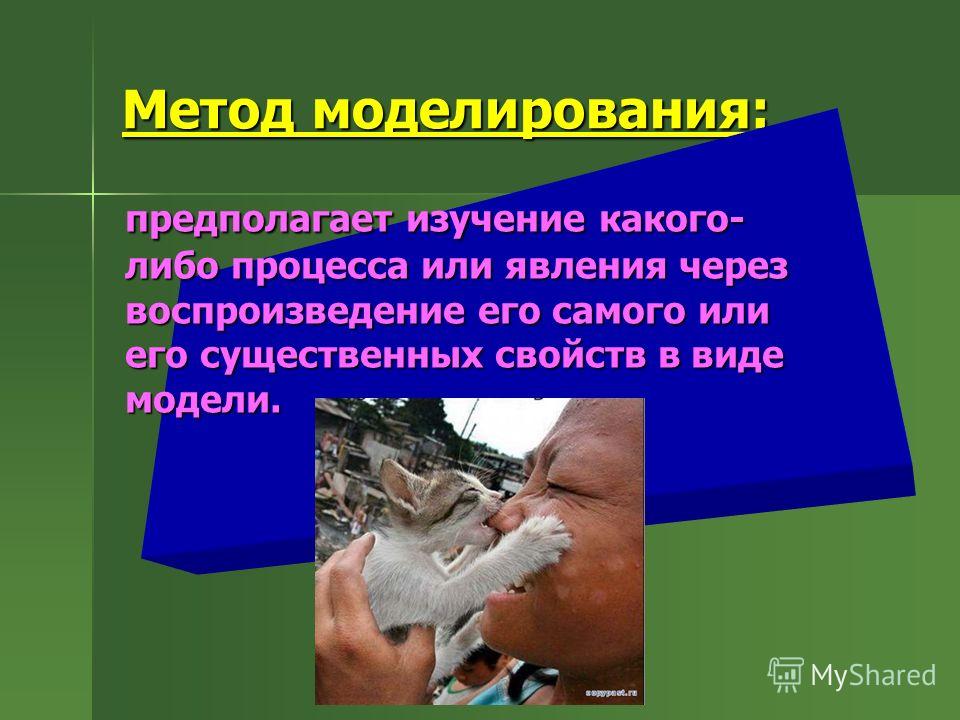
4. The value of biology In medicine, psychology, sociology - is a scientific theoretical base. IN Food Industry- cultivation of organisms used for food from a single cell, the creation of various dietary supplements. In the matter of nature conservation, all the ties of mankind with environment should be built on the basis of knowledge of the laws of functioning of ecological systems and the biosphere as a whole.
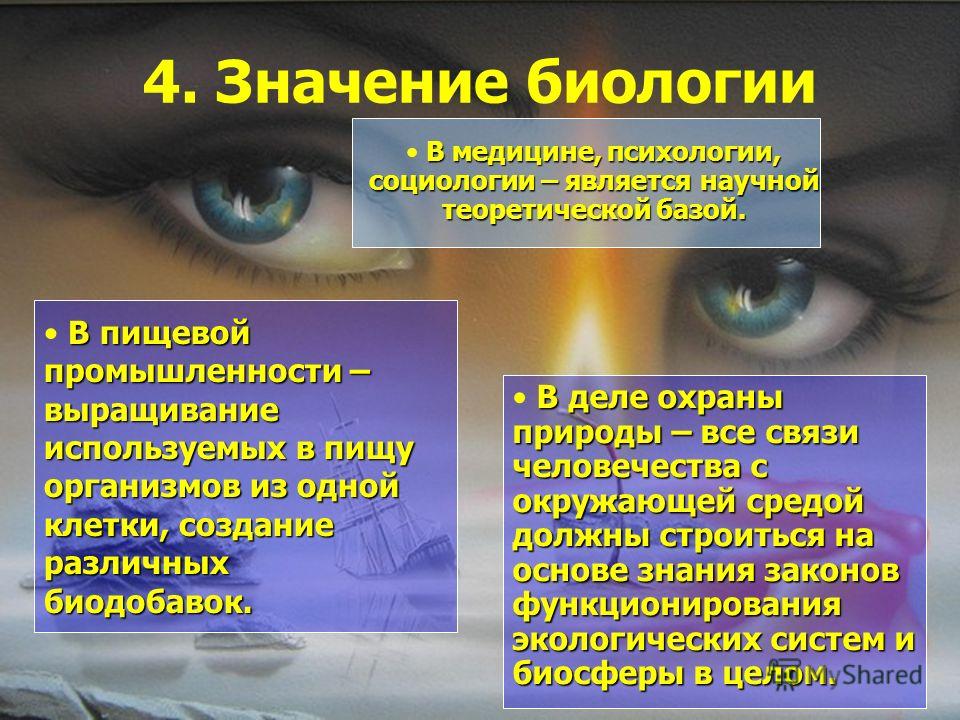
Task: Read on pg. about the importance of biology in modern life and complete assignment 3-4 in the printed notebook on page 5.
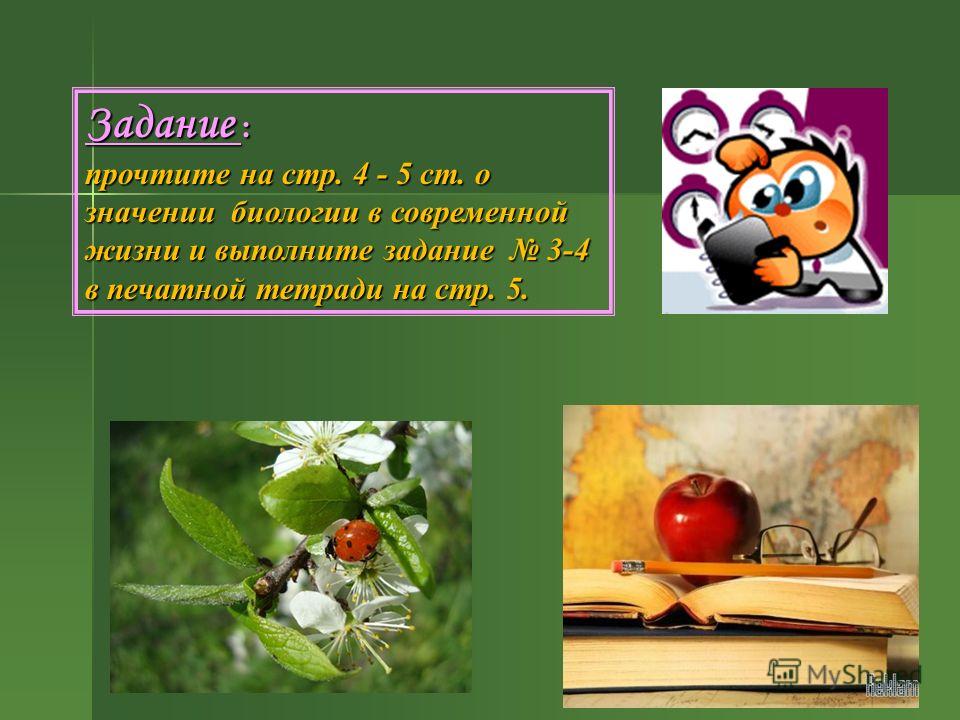
1 slide
Presentation on the subject "Biology" The presentation was prepared by a 10th grade student E. Noikova. Topic: "The role of biology in space research."
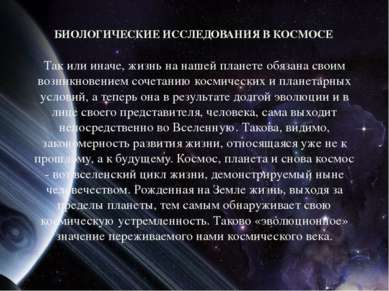
2 slide
BIOLOGICAL RESEARCH IN SPACE One way or another, life on our planet owes its origin to a combination of cosmic and planetary conditions, and now, as a result of a long evolution and in the person of its representative, man, it itself goes directly into the Universe. Such, apparently, is the regularity of the development of life, which no longer refers to the past, but to the future. Space, planet and space again - this is the universal cycle of life, now demonstrated by mankind. Life born on Earth, going beyond the planet, thereby reveals its cosmic striving. Such is the "evolutionary" meaning of the cosmic age we are experiencing.

3 slide
The launch in 1957 of the first artificial Earth satellite and the further development of astronautics posed great and complex problems for various fields of science. New branches of knowledge have emerged. One of them is space biology. Back in 1908, K. E. Tsiolkovsky expressed the idea that after the creation of an artificial Earth satellite capable of returning to Earth without damage, the solution of biological problems related to ensuring the life of spacecraft crews will be in turn. Indeed, before the first earthling, a citizen of the Soviet Union, Yuri Alekseevich Gagarin, went on a space flight on the Vostok-1 spacecraft, extensive medical biological research on artificial earth satellites and spacecraft. They went on a space flight Guinea pigs, mice, dogs, higher plants and algae (chlorella), various microorganisms, plant seeds, isolated human and rabbit tissue cultures, and others biological objects. These experiments allowed scientists to conclude that life in space flight (at least not too long) is possible. This was the first important achievement of a new field of natural science - space biology. Mice are tested in weightlessness conditions Belka and Strelka Drosophila flies, silkworm eggs, mushrooms and seeds flew away on Foton-M higher plants
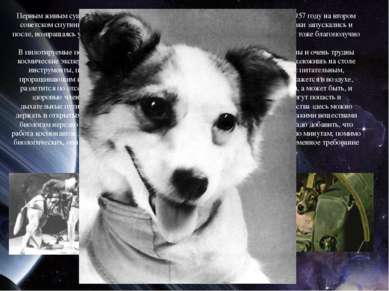
4 slide
The first living creature to leave the planet was the dog Laika, launched in 1957 on the second Soviet satellite, a month after the launch of the famous first Sputnik. The dogs were also launched after, returning already alive and healthy. And in 1983 and 1985, monkeys flew into space and also safely returned to Earth. So far, cosmonauts do not take higher animals with them on manned flights. Complicated and very difficult space experiments on living material. In the ship, with its weightlessness, you can't lay out tools, experimental animals or even plants on the table, you can't arrange jars with nutrient, germinating and fixing solutions. Before you have time to look back, all this will be in the air, scattered throughout the compartment. And this is not only a failure of experience, but also a threat to the entire flight program, and perhaps to the health of the crew members. The smallest droplets of liquid suspended in the air can get into Airways person, disrupt the operation of complex equipment. And not all substances here can be kept in open vessels. Those that are even slightly harmful to humans (and biologists often have to deal with such substances) require strict sealing. To this it must be added that the work of cosmonauts, even in long, months-long flights, is scheduled literally by the minute; in addition to biological, they perform many other programs. Hence - one more indispensable requirement for all experiments: the maximum simplicity of operations.

5 slide
We will tell about how scientists unravel this tangle of contradictions between the objectives of the study and the severely restrictive conditions for its implementation, how they set up interesting experiments, we will tell on the example of experiments with a fruit fly - Drosophila. These insects, veterans of cosmobiological research, started in biosatellites, in manned spacecraft, traveled to the moon and back on automatic probes "Zond". Keeping flies in space does not cause much trouble. They do not need special blocks with a life support system. They feel quite well in an ordinary test tube, at the bottom of which a little nutrient broth is poured. At the Salyut stations, experiments with Drosophila were carried out in special thermostats at a constant, strictly controlled temperature. The biocontainer, designed for experiments on developing larvae and pupae, consists of four plastic tubes inserted into the sockets of a rectangular foam plastic stand. The test tubes are placed in a thermostat, which automatically maintains a temperature of +25 degrees. This instrument, which was flown on the Soyuz and Salyuts, is light and compact, and does not require any special actions or observations in flight. Upon completion of the experiment, when one generation of flies has been grown, the biocontainer is removed from the thermostat and sent to the Earth in the next transport ship.

6 slide
However, it is much more interesting to get several generations of fruit flies in weightlessness: it would turn out to be real “ethereal creatures”, if we use the terminology of Tsiolkovsky, which not only develop, but are also born in space. And it's not a matter of terminology, but of experimental confirmation of one of the most daring hypotheses of the Kaluga scientist. For experiments of this kind, another device was created. It is a plastic cube with a face about 10 centimeters long, assembled from sections with a nutrient medium and doors between them. During the flight, the cosmonauts take this cube out of the thermostat at the right time and open access to the second section for the insects in the first section. The flies lay eggs on the new "living space", giving life to the next generation. Purely cosmic larvae emerge from such testicles. They, in turn, turn into pupae, then into flies, which are transferred to the next compartment of the device and there they hatch the next cosmic offspring. This is exactly what happened in reality. Living creatures, even if only fruit flies so far, are able to live and reproduce outside the Earth. This important and promising conclusion, made on the basis of a space experiment, proves that life and space are not contraindicated for each other.

7 slide
Thus, the methods of space biology differ a high degree automation, are closely related to radio electronics and electrical engineering, radio telemetry and computer technology. The researcher needs to have a good knowledge of all these technical means, and, in addition, he needs a deep knowledge of the mechanisms of various biological processes. What are the challenges facing space biology? The most important of them are three: The study of the influence of space flight conditions and space factors on the living organisms of the Earth. Investigation of the biological foundations of life support in the conditions of space flights, on extraterrestrial and planetary stations. The search for living matter and organic matter in world space and the study of features and forms of extraterrestrial life.
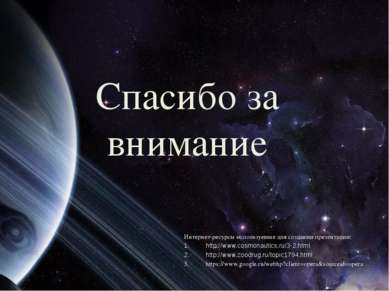
8 slide
Thank you for your attention Internet resources used to create the presentation: http://www.cosmonautics.ru/3-2.html http://www.zoodrug.ru/topic1794.html https://www.google.ru/webhp ?client=opera&sourceid=opera
There are a lot of directions for a person to use knowledge in biology, for example, here are a few (let's go from large to small):
Knowledge laws of ecology allows you to regulate human activities within the limits of the conservation of the ecosystem in which he lives and works (rational nature management);
· Botany and genetics allow you to increase productivity, fight pests and bring out new, necessary and useful varieties;
· Genetics at the moment so tightly intertwined with medicine that many diseases that were previously considered incurable are studied and prevented already at the embryonic stages of human development;
· With the help of microbiology, scientists around the world are developing sera and vaccines against viruses and a wide variety of antibacterial drugs.
Differences between living structures and non-living ones. properties of the living
Biology The science that studies the properties of living systems. However, to determine what living system, It's hard enough. The line between living and non-living is not as easy to draw as it seems. Try to answer the questions, are viruses alive when they rest outside the host organism and do not metabolize them? Can artificial objects and machines exhibit the properties of living things? A computer programs? Or languages?
To answer these questions, one can try to isolate minimum set properties characteristic of living systems. That is why scientists have established several criteria by which an organism can be classified as living.
The most important of characteristic properties(criteria) live are the following:
1. Exchange of matter and energy with the environment. From the point of view of physics, all living systems are open, that is, they constantly exchange both matter and energy with the environment, in contrast to closed completely isolated from the outside world, and semi-closed that exchange only energy, not matter. We shall see later that this exchange is a necessary condition for the existence of life.
2. Living systems are capable of accumulating substances from the environment and, as a result, growth.
3. Modern biology considers the ability to be identical (or almost identical) to be a fundamental property of living beings self-reproduction, that is, reproduction with the preservation of most of the properties of the original organism.
4. Identical self-reproduction is inextricably linked with the concept heredity, that is, the transfer of signs and properties to offspring.
5. However, heredity is not absolute - if all daughter organisms exactly copied the parent ones, then no evolution would be possible, since living organisms would never change. This would lead to the fact that for any abrupt change conditions, they would all die. But life is extremely flexible, and organisms adapt to the widest range conditions. This is possible thanks to variability- the fact that the self-reproduction of organisms is not completely identical, in the course of it errors and variations occur, which can be material for selection. There is a certain balance between heredity and variability.
6. Variability can be hereditary and non-hereditary. Hereditary variability, that is, the emergence of new variations of traits that are inherited and fixed in a number of generations, serves as material for natural selection. Natural selection is possible among any reproducing objects, not necessarily living ones, if there is competition between them for limited resources. Those objects that, due to variability, have acquired unsuitable in a given environment, adverse signs, will be rejected, so the features that give a competitive advantage in the fight will be found more and more often in new objects. That's what it is natural selection- a creative factor in evolution, thanks to which all the diversity of living organisms on Earth arose.
7. Living organisms actively respond to external signals, showing the property irritability.
8. Due to their ability to respond to changing external conditions, living organisms are capable of adaptation- adaptation to new conditions. This property, in particular, allows organisms to survive various cataclysms and spread to new territories.
9. Adaptation is carried out by self-regulation, that is, the ability to maintain the constancy of certain physical and chemical parameters in a living organism, including in changing environmental conditions. For example, the human body maintains constant temperature, the concentration of glucose in the blood and many other substances.
10. An important property earthly life is discreteness, that is, discontinuity: it is represented by individual individuals, individuals are united in populations, populations - into species, etc., that is, at all levels of organization of the living there are separate units. Stanisław Lem's science fiction novel Solaris describes a vast living ocean that covers the entire planet. But there are no such life forms on Earth.
Chemical composition alive
Living organisms are made up of many chemical substances, organic and inorganic, polymeric and low molecular weight. Many chemical elements present in the environment have been found in living systems, but only about 20 of them are necessary for life. These elements are called biogenic.
In the process of evolution from inorganic substances to bioorganic the basis for the use of certain chemical elements in the creation of biosystems is natural selection. As a result of such selection, only six elements form the basis of all living systems: carbon, hydrogen, oxygen, nitrogen, phosphorus, and sulfur, which are called organogens. Their content in the body reaches 97.4%.
Organogens are the main chemical elements that make up organic substances: carbon, hydrogen, oxygen and nitrogen.
From the point of view of chemistry, the natural selection of organogenic elements can be explained by their ability to form chemical bonds: on the one hand, they are strong enough, that is, energy-intensive, and on the other hand, they are quite labile, which could easily succumb to hemolysis, heterolysis, and cyclic redistribution.
The number one organogen is undoubtedly carbon. Its atoms form strong covalent bonds with each other or with atoms of other elements. These bonds can be single or multiple, thanks to these 3 bonds, carbon is able to form conjugated or cumulated systems in the form of open or closed chains, cycles.
Unlike carbon, the organogenic elements hydrogen and oxygen do not form labile bonds, but their presence in an organic, including a bioorganic, molecule determines its ability to interact with a biosolvent-water. In addition, hydrogen and oxygen are carriers of the redox properties of living systems, they ensure the unity of redox processes.
The remaining three organogens - nitrogen, phosphorus and sulfur, as well as some other elements - iron, magnesium, which make up the active centers of enzymes, like carbon, are capable of forming labile bonds. positive property organogens is also the fact that they, as a rule, form compounds that are readily soluble in water and therefore concentrate in the body.
There are several classifications of chemical elements contained in the human body. So, V.I. Vernadsky, depending on the average content in living organisms, divided the elements into three groups:
1. Macronutrients. These are elements whose content in the body is above 10 - ² %. These include carbon, hydrogen, oxygen, nitrogen, phosphorus, sulfur, calcium, magnesium, sodium and chlorine, potassium, and iron. These so-called universal biogenic elements present in the cells of all organisms.
2. Trace elements. These are elements whose content in the body is in the range from 10 - ² to 10 - ¹²%. These include iodine, copper, arsenic, fluorine, bromine, strontium, barium, cobalt. Although these elements are found in organisms in extremely low concentrations(no more than a thousandth of a percent), but they are also necessary for normal life. These are biogenic trace elements. Their functions and roles are very diverse. Many trace elements are part of a number of enzymes, vitamins, respiratory pigments, some affect growth, development rate, reproduction, etc.
3. Ultramicroelements. These are elements whose content in the body is below 10-¹²%. These include mercury, gold, uranium, radium, etc.
V.V. Kovalsky, based on the degree of importance of chemical elements for human life, divided them into three groups:
1. Essential elements. They are constantly in the human body, are part of its inorganic and organic compounds. These are H, O, Ca, N, K, P, Na, S, Mg, Cl, C, I, Mn, Cu, Co, Zn, Fe, Mo, V. Deficiency of these elements leads to disruption of the normal functioning of the body.
2. Impurity elements. These elements are constantly present in the human body, but their biological role is not always clear or little studied. These are Ga, Sb, Sr, Br, F, B, Be, Li, Si, Sn, Cs, As, Ba, Ge, Rb, Pb, Ra, Bi, Cd, Cr, Ni, Ti, Ag, Th, Hg , Ce, Se.
3. Trace elements. They are found in the human body, but neither about the quantitative content nor about biological role They are not here. These are Sc, Tl, In, La, Sm, Pr, W, Re, Tb, etc. Chemical elements, necessary for the construction and vital activity of cells and organisms, are called biogenic.
Among inorganic substances and components, the main place is occupied by - water.
Certain concentrations of inorganic ions are necessary to maintain the ionic strength and pH environment at which vital processes take place. To maintain a certain ionic strength and connect the buffer medium, the participation of singly charged ions is necessary: ammonium (NH4 +); sodium(Na+); potassium (K+). Cations are not mutually substituted, there are special mechanisms that maintain the necessary balance between them.
Inorganic Compounds:
Ammonium salts;
Carbonates;
sulfates;
Phosphates.
non-metals:
1. Chlorine (basic). In the form of anions, it participates in the creation of a salt environment, sometimes it is part of some organic substances.
2. Iodine and its compounds take part in some vital processes of organic compounds (living organisms). Iodine is part of the hormones thyroid gland(thyroxine).
3. Derivatives of selenium. Selenocysteine is part of some enzymes.
4. Silicon - is part of the cartilage and ligaments, in the form of esters of orthosilicic acid, takes part in the cross-linking of polysaccharide chains.
Many compounds in living organisms are complexes: heme is a complex of iron with a flat paraffin molecule; cobolamine.
Magnesium and calcium are the main metals, not counting iron, are ubiquitous in biosystems. The concentration of magnesium ions has importance to maintain the integrity and functioning of ribosomes, that is, for the synthesis of proteins.
Magnesium is also part of chlorophyll. Calcium ions are involved in cellular processes including muscle contractions. Undissolved salts - participate in the formation of supporting structures:
calcium phosphate (in bones);
Carbonate (in mollusk shells).
Metal ions of the 4th period are part of a number of vital compounds - enzymes. Some proteins contain iron in the form of iron-sulfur clusters. Zinc ions are contained in a significant number of enzymes. Manganese is part of a small number of enzymes, but plays an important role in the biosphere, in the photochemical reduction of water, ensures the release of oxygen into the atmosphere and the supply of electrons to the transfer chain during photosynthesis.
Cobalt - is part of the enzymes in the form of - cobalamins (vitamin B 12).
Molybdenum - a necessary component of the enzyme - nitrodinase (which catalyzes the reduction of atmospheric nitrogen to ammonia, in nitrogen-fixing bacteria)
Big number organic matter is part of living organisms: acetic acid; acetaldehyde; ethanol (is the products and substrates of biochemical transformations).
The main groups of low molecular weight compounds of living organisms:
Amino acids are constituent parts proteins
Nucleamides are part of nucleic acids.
Mono and aligosaccharides - components of structural tissues
Lipids are constituents of cell walls.
In addition to the previous ones, there are:
Enzyme cofactors are necessary components of a significant number of enzymes that catalyze redox reactions.
Coenzymes are organic compounds that function in certain systems of enzymatic reactions. For example: nicotinoamidodanine dinucleatide (NAD+). In the oxidized form, it is an oxidizer of alcohol groups to carbonyl groups, and a reducing agent is formed.
Enzyme cofactors are complex organic molecules synthesized from complex precursors that must be present as essential components of food.
Higher animals are characterized by the formation and functioning of substances that control the nervous and endocrine system hormones and neurotransmitters. For example, the adrenal hormone triggers the oxidative processing of glycogen in the processes of a stressful situation.
Many plants synthesize a complex amine with a strong biological effect - alkaloids.
Terpenes - compounds plant origin, Components essential oils and resin.
Antibiotics are substances of microbiological origin secreted by special types of microorganisms that inhibit the growth of other competing microorganisms. Their mechanism of action is diverse, such as slowing down the growth of proteins in bacteria.
The role of biology in modern reality is difficult to overestimate, because it studies in detail human life in all its manifestations. At present, this science combines such important concepts as evolution, cell theory, genetics, homeostasis and energy. Its functions include the study of the development of all living things, namely: the structure of organisms, their behavior, as well as the relationship between themselves and the relationship with the environment. The importance of biology in human life becomes clear if we draw a parallel between the main problems of an individual's life, for example, health, nutrition, and choice. optimal conditions existence. To date, numerous sciences are known that have separated from biology, becoming no less important and independent. These include zoology, botany, microbiology, and virology. Of these, it is difficult to single out the most significant, they all represent a complex of the most valuable fundamental knowledge accumulated by civilization.

In system medical education The study of biology is determined by the fact that biology is theoretical background medicine. Since a person is a part of wildlife, the laws of the structure and functioning of living organisms apply to the processes of human life in normal and pathological conditions. “Medicine, taken in terms of theory, is, first of all, general biology,” wrote one of the largest theoreticians of medicine, I.V. Davydovsky. All medical sciences use fundamental knowledge about the general biological patterns of human development, structure and life.
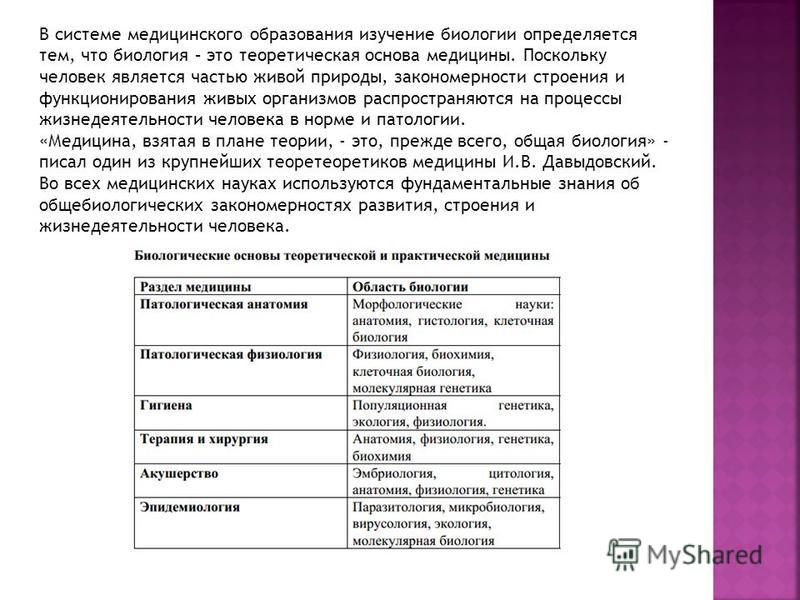
The advances and discoveries of biology determined the modern level medical science. Ideas about macro- and microscopic structure human body, about the functions of its organs and cells are based mainly on biological research. Histology and human physiology, which serve as the foundation of medical disciplines, are studied by both physicians and biologists. The doctrine of the causes and spread of infectious diseases and the principles of their control is based on microbiological and virological studies. Ideas about the mechanisms of immunity underlying the body's resistance to infections are also based on biological research. Studied chemical structure antibodies, the mechanisms of their synthesis are being studied. Of particular importance for medicine is the study of tissue incompatibility, the main obstacle to organ and tissue transplantation. For suppression immune system organisms enjoy X-ray exposure and chemicals.
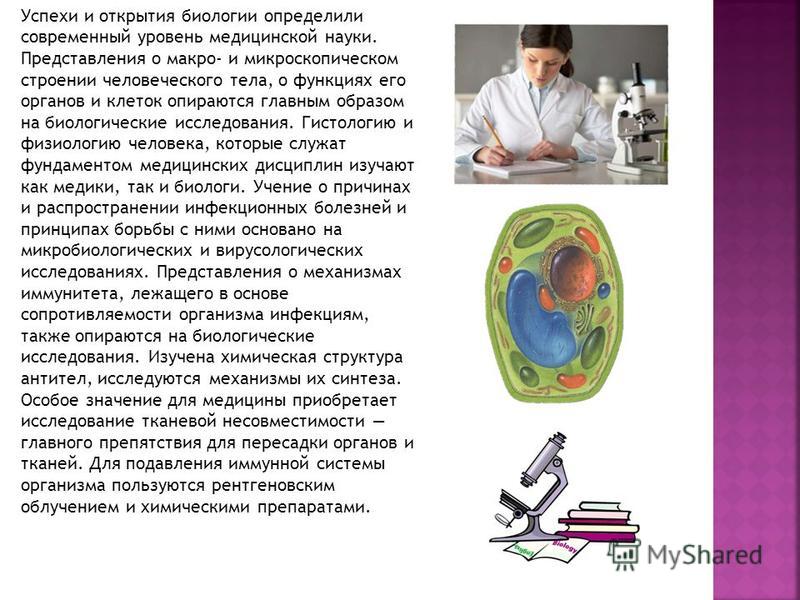
A true revolution in treatment infectious diseases, which in the past was the main cause of death, is associated with the discovery of antibiotics. Mass production of cheap antibiotics became possible only after the breeding of highly productive strains of antibiotic producers, achieved by the methods of modern genetics. With the increase medium duration life of people, due to a large extent to the successes of medicine, the proportion of diseases of older age, cardiovascular, malignant neoplasms as well as hereditary diseases. This put before modern medicine new problems in the solution of which biology plays an important role. Cytologists, embryologists, geneticists, biochemists, immunologists, and virologists work as a united front on the problem of cancer. Human genetics, including medical genetics, which studies hereditary diseases, is now becoming an important object of biomedical research. Already amenable accurate diagnosis diseases associated with a violation of the number of chromosomes. Genetic analysis allows to detect harmful mutations in humans. The fight against them is carried out through treatment and medical genetic consultations and recommendations.
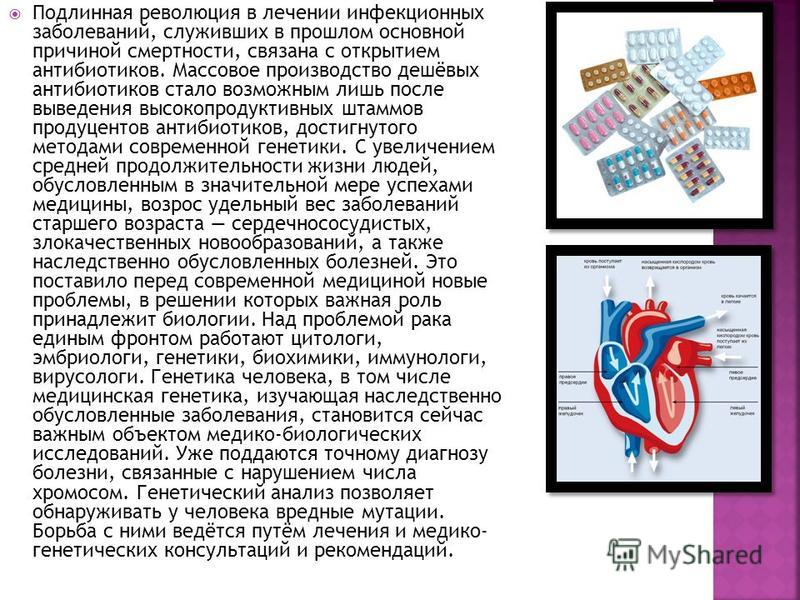
The role of biology in modern society is expressed in the fact that it has now been transformed into a real force. Thanks to her knowledge, the prosperity of our planet is possible. That is why the answer to the question of what is the role of biology in modern society can be this - this is the cherished key to harmony between nature and man.
